Marketing Essentials Report: The Role of Marketing and Mix Elements
VerifiedAdded on 2021/01/03
|27
|5673
|185
Report
AI Summary
This report delves into the essentials of marketing, examining the role of marketing within an organization and its interplay with other functional units. It introduces key marketing concepts, current trends, and the marketing process, including the marketing intelligence model and the 7Ps of the marketing mix. The report then explores the roles and responsibilities of a marketing manager, detailing their strategic duties and interactions with other departments, and their influence on business decisions. Furthermore, the report provides a comparison of marketing mix elements, focusing on product, price, and place, using O2 and Vodafone as examples. The analysis considers the importance of innovation, pricing strategies, and distribution channels in the competitive telecommunications market. This report offers a comprehensive overview of marketing principles and their practical application.

Marketing Essentials
1
1
Paraphrase This Document
Need a fresh take? Get an instant paraphrase of this document with our AI Paraphraser
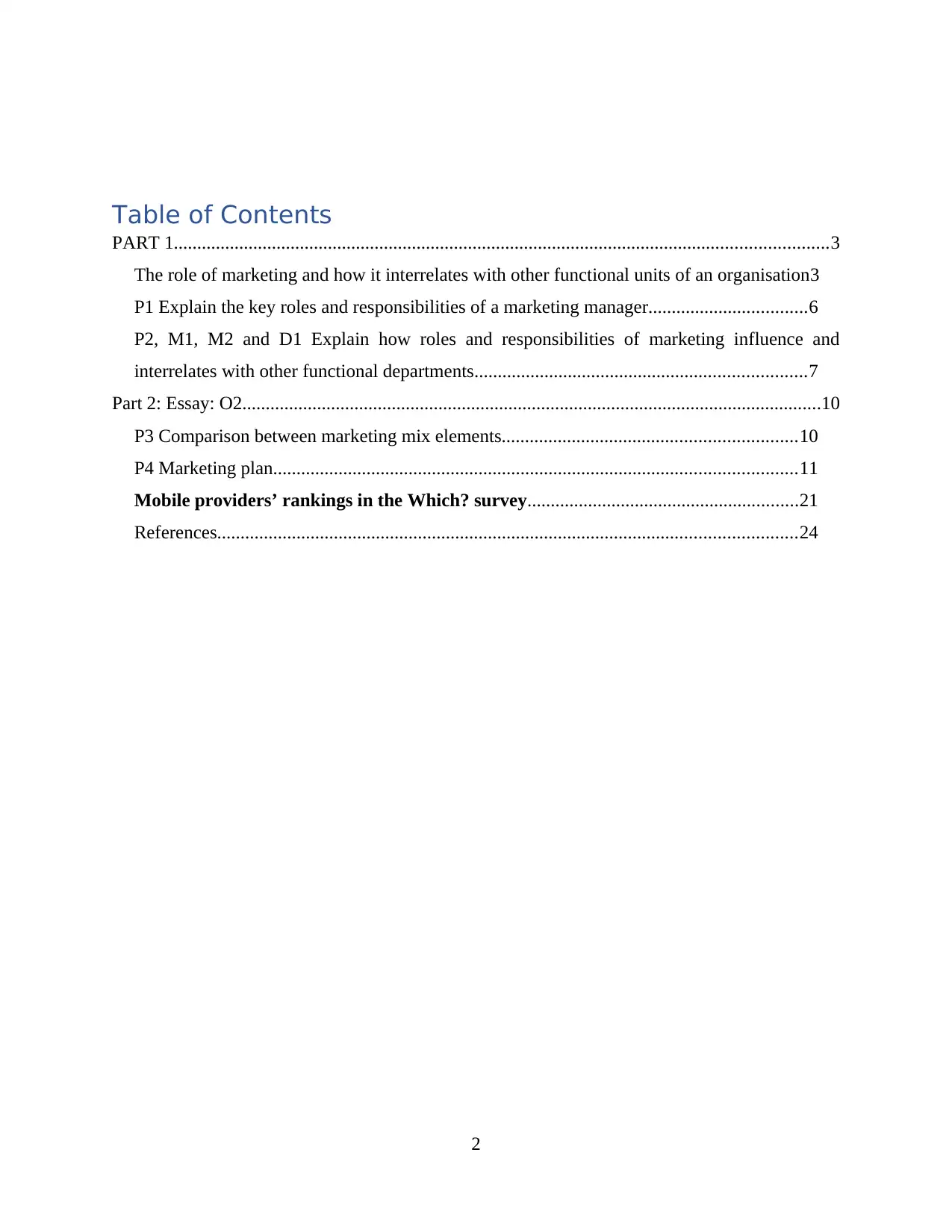
Table of Contents
PART 1............................................................................................................................................3
The role of marketing and how it interrelates with other functional units of an organisation3
P1 Explain the key roles and responsibilities of a marketing manager..................................6
P2, M1, M2 and D1 Explain how roles and responsibilities of marketing influence and
interrelates with other functional departments.......................................................................7
Part 2: Essay: O2............................................................................................................................10
P3 Comparison between marketing mix elements...............................................................10
P4 Marketing plan................................................................................................................11
Mobile providers’ rankings in the Which? survey..........................................................21
References............................................................................................................................24
2
PART 1............................................................................................................................................3
The role of marketing and how it interrelates with other functional units of an organisation3
P1 Explain the key roles and responsibilities of a marketing manager..................................6
P2, M1, M2 and D1 Explain how roles and responsibilities of marketing influence and
interrelates with other functional departments.......................................................................7
Part 2: Essay: O2............................................................................................................................10
P3 Comparison between marketing mix elements...............................................................10
P4 Marketing plan................................................................................................................11
Mobile providers’ rankings in the Which? survey..........................................................21
References............................................................................................................................24
2
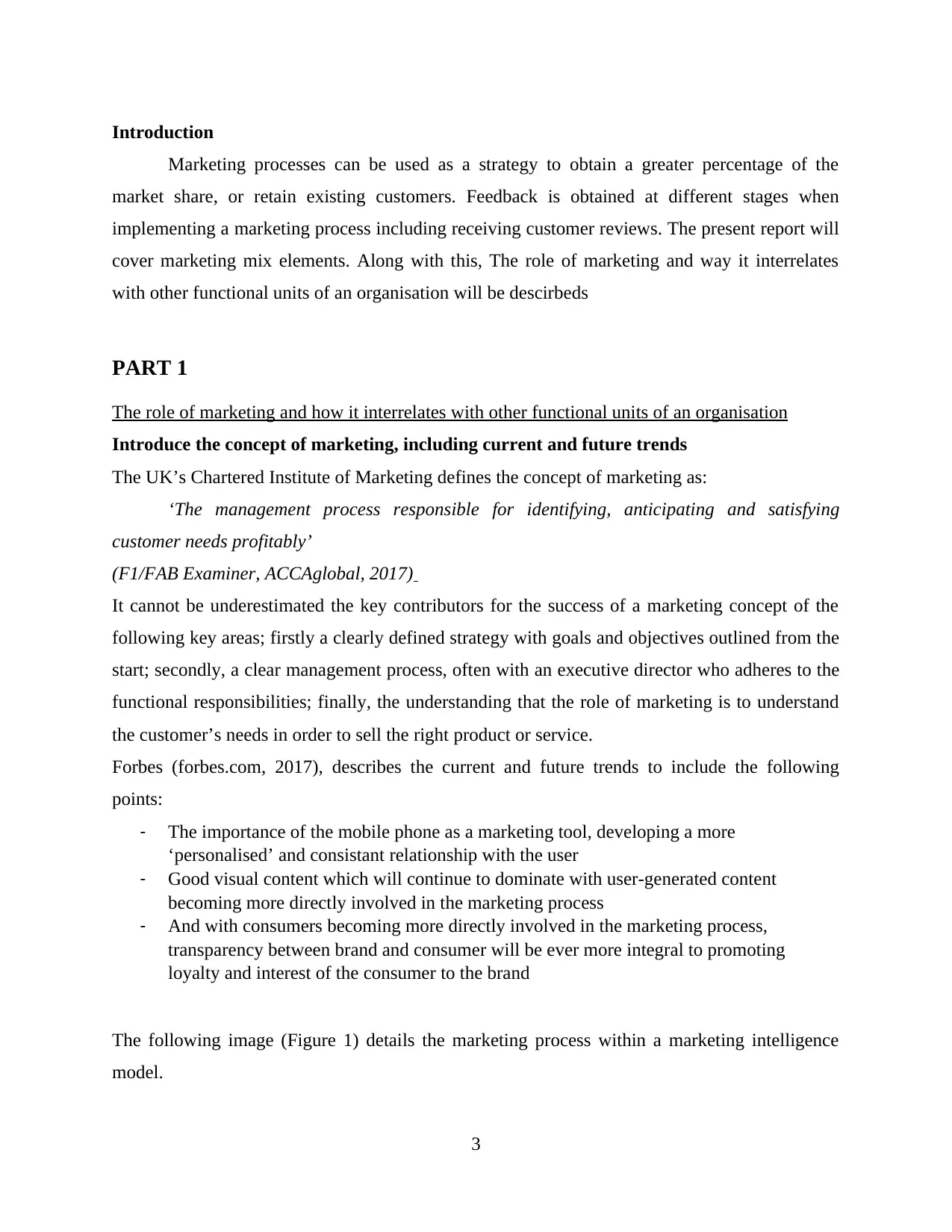
Introduction
Marketing processes can be used as a strategy to obtain a greater percentage of the
market share, or retain existing customers. Feedback is obtained at different stages when
implementing a marketing process including receiving customer reviews. The present report will
cover marketing mix elements. Along with this, The role of marketing and way it interrelates
with other functional units of an organisation will be descirbeds
PART 1
The role of marketing and how it interrelates with other functional units of an organisation
Introduce the concept of marketing, including current and future trends
The UK’s Chartered Institute of Marketing defines the concept of marketing as:
‘The management process responsible for identifying, anticipating and satisfying
customer needs profitably’
(F1/FAB Examiner, ACCAglobal, 2017)
It cannot be underestimated the key contributors for the success of a marketing concept of the
following key areas; firstly a clearly defined strategy with goals and objectives outlined from the
start; secondly, a clear management process, often with an executive director who adheres to the
functional responsibilities; finally, the understanding that the role of marketing is to understand
the customer’s needs in order to sell the right product or service.
Forbes (forbes.com, 2017), describes the current and future trends to include the following
points:
- The importance of the mobile phone as a marketing tool, developing a more
‘personalised’ and consistant relationship with the user
- Good visual content which will continue to dominate with user-generated content
becoming more directly involved in the marketing process
- And with consumers becoming more directly involved in the marketing process,
transparency between brand and consumer will be ever more integral to promoting
loyalty and interest of the consumer to the brand
The following image (Figure 1) details the marketing process within a marketing intelligence
model.
3
Marketing processes can be used as a strategy to obtain a greater percentage of the
market share, or retain existing customers. Feedback is obtained at different stages when
implementing a marketing process including receiving customer reviews. The present report will
cover marketing mix elements. Along with this, The role of marketing and way it interrelates
with other functional units of an organisation will be descirbeds
PART 1
The role of marketing and how it interrelates with other functional units of an organisation
Introduce the concept of marketing, including current and future trends
The UK’s Chartered Institute of Marketing defines the concept of marketing as:
‘The management process responsible for identifying, anticipating and satisfying
customer needs profitably’
(F1/FAB Examiner, ACCAglobal, 2017)
It cannot be underestimated the key contributors for the success of a marketing concept of the
following key areas; firstly a clearly defined strategy with goals and objectives outlined from the
start; secondly, a clear management process, often with an executive director who adheres to the
functional responsibilities; finally, the understanding that the role of marketing is to understand
the customer’s needs in order to sell the right product or service.
Forbes (forbes.com, 2017), describes the current and future trends to include the following
points:
- The importance of the mobile phone as a marketing tool, developing a more
‘personalised’ and consistant relationship with the user
- Good visual content which will continue to dominate with user-generated content
becoming more directly involved in the marketing process
- And with consumers becoming more directly involved in the marketing process,
transparency between brand and consumer will be ever more integral to promoting
loyalty and interest of the consumer to the brand
The following image (Figure 1) details the marketing process within a marketing intelligence
model.
3
⊘ This is a preview!⊘
Do you want full access?
Subscribe today to unlock all pages.

Trusted by 1+ million students worldwide
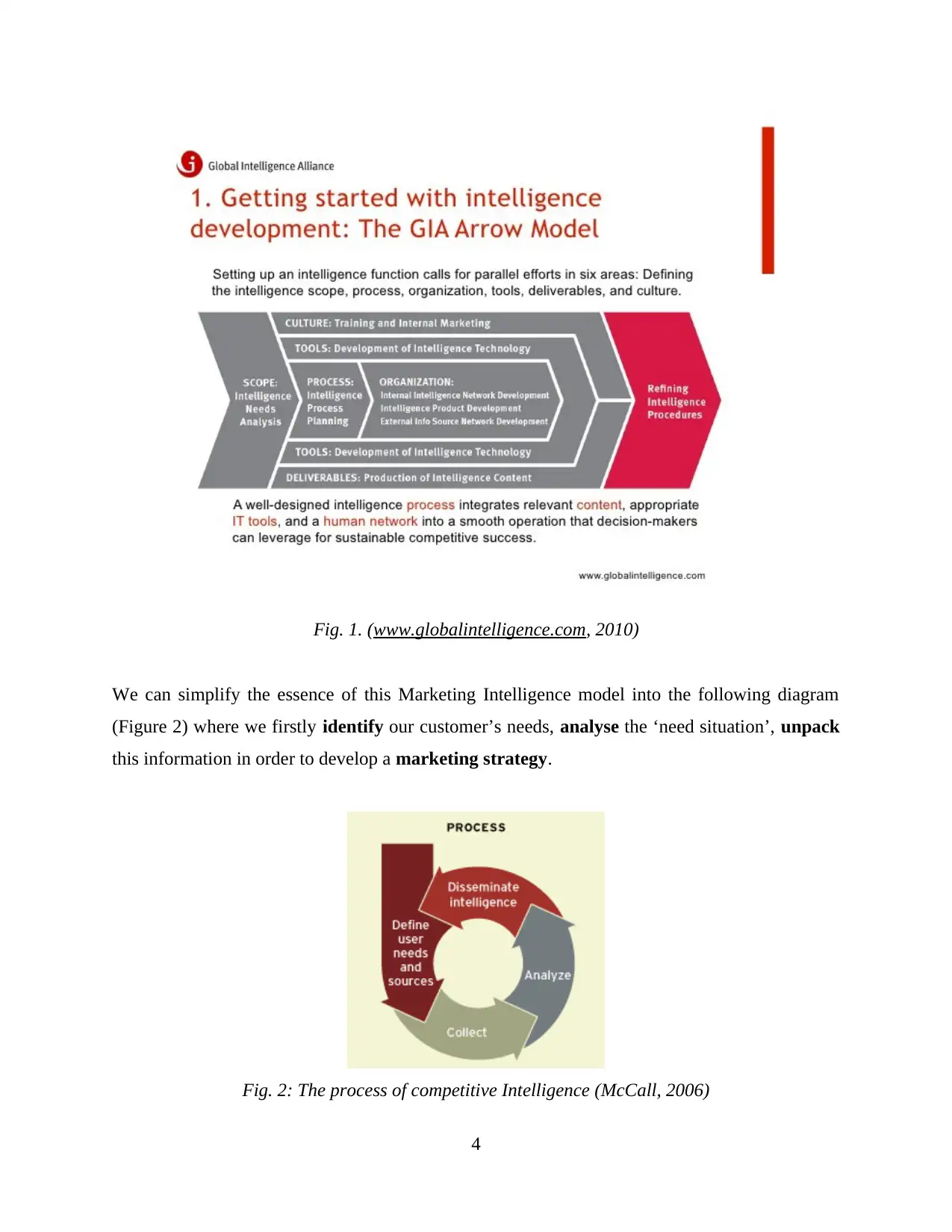
Fig. 1. (www.globalintelligence.com, 2010)
We can simplify the essence of this Marketing Intelligence model into the following diagram
(Figure 2) where we firstly identify our customer’s needs, analyse the ‘need situation’, unpack
this information in order to develop a marketing strategy.
Fig. 2: The process of competitive Intelligence (McCall, 2006)
4
We can simplify the essence of this Marketing Intelligence model into the following diagram
(Figure 2) where we firstly identify our customer’s needs, analyse the ‘need situation’, unpack
this information in order to develop a marketing strategy.
Fig. 2: The process of competitive Intelligence (McCall, 2006)
4
Paraphrase This Document
Need a fresh take? Get an instant paraphrase of this document with our AI Paraphraser
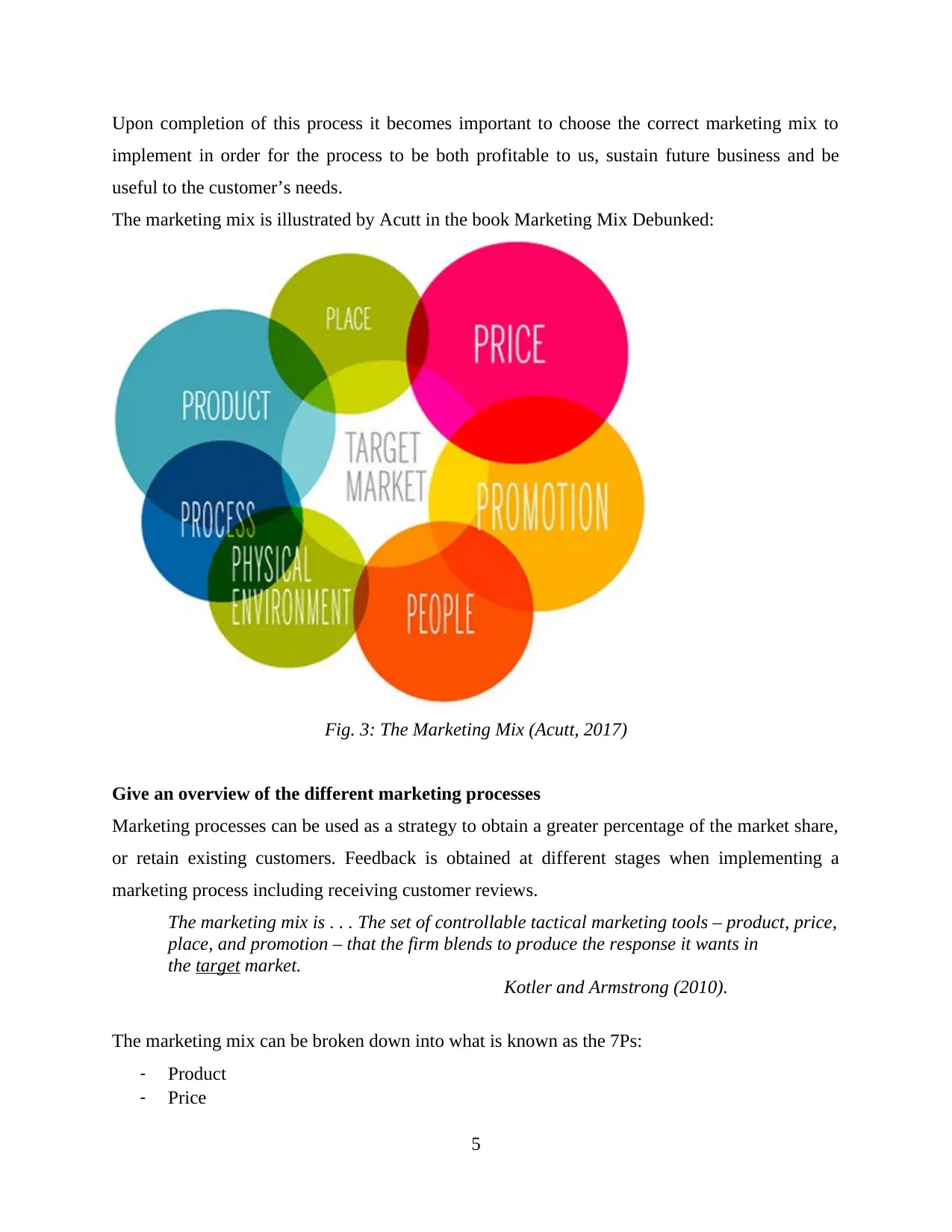
Upon completion of this process it becomes important to choose the correct marketing mix to
implement in order for the process to be both profitable to us, sustain future business and be
useful to the customer’s needs.
The marketing mix is illustrated by Acutt in the book Marketing Mix Debunked:
Fig. 3: The Marketing Mix (Acutt, 2017)
Give an overview of the different marketing processes
Marketing processes can be used as a strategy to obtain a greater percentage of the market share,
or retain existing customers. Feedback is obtained at different stages when implementing a
marketing process including receiving customer reviews.
The marketing mix is . . . The set of controllable tactical marketing tools – product, price,
place, and promotion – that the firm blends to produce the response it wants in
the target market.
Kotler and Armstrong (2010).
The marketing mix can be broken down into what is known as the 7Ps:
- Product
- Price
5
implement in order for the process to be both profitable to us, sustain future business and be
useful to the customer’s needs.
The marketing mix is illustrated by Acutt in the book Marketing Mix Debunked:
Fig. 3: The Marketing Mix (Acutt, 2017)
Give an overview of the different marketing processes
Marketing processes can be used as a strategy to obtain a greater percentage of the market share,
or retain existing customers. Feedback is obtained at different stages when implementing a
marketing process including receiving customer reviews.
The marketing mix is . . . The set of controllable tactical marketing tools – product, price,
place, and promotion – that the firm blends to produce the response it wants in
the target market.
Kotler and Armstrong (2010).
The marketing mix can be broken down into what is known as the 7Ps:
- Product
- Price
5
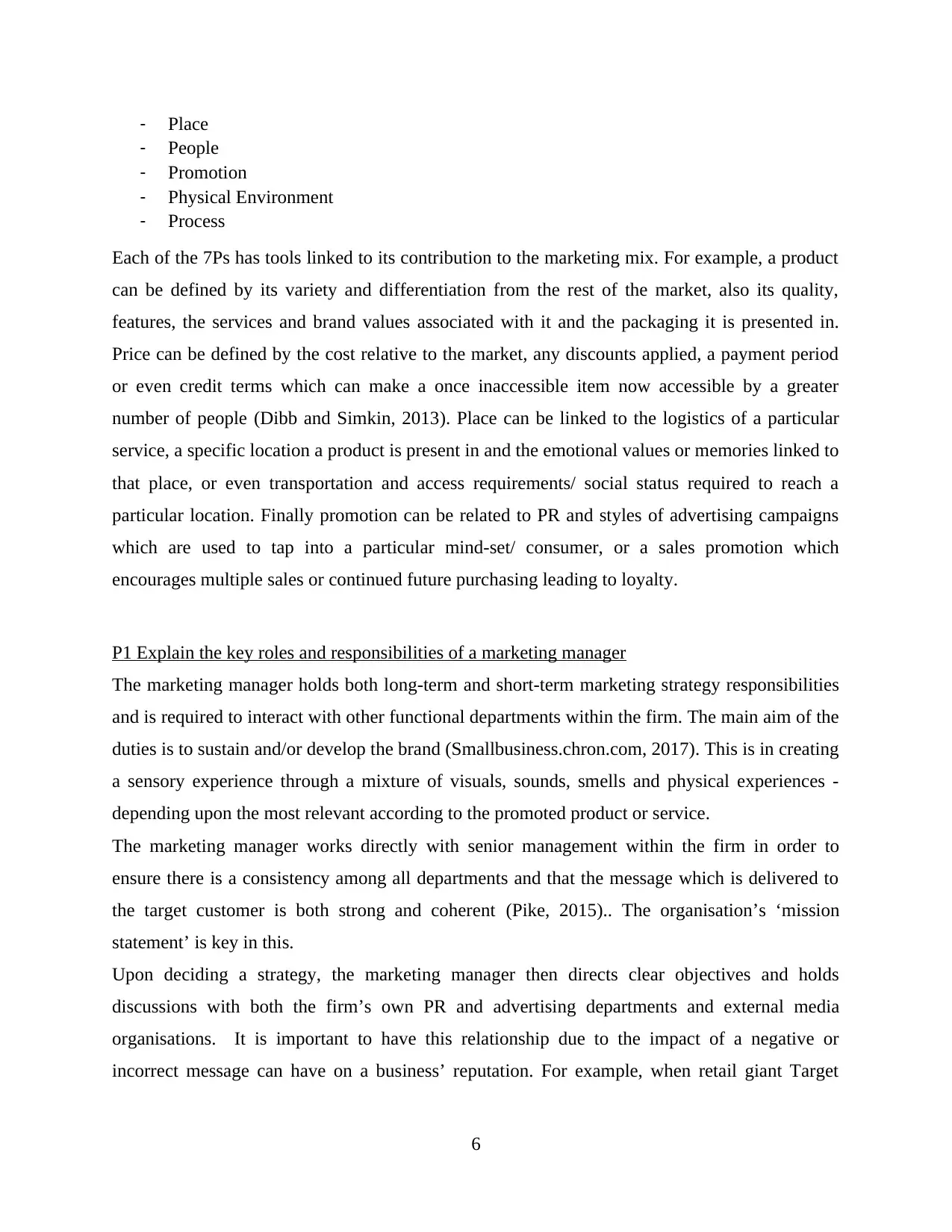
- Place
- People
- Promotion
- Physical Environment
- Process
Each of the 7Ps has tools linked to its contribution to the marketing mix. For example, a product
can be defined by its variety and differentiation from the rest of the market, also its quality,
features, the services and brand values associated with it and the packaging it is presented in.
Price can be defined by the cost relative to the market, any discounts applied, a payment period
or even credit terms which can make a once inaccessible item now accessible by a greater
number of people (Dibb and Simkin, 2013). Place can be linked to the logistics of a particular
service, a specific location a product is present in and the emotional values or memories linked to
that place, or even transportation and access requirements/ social status required to reach a
particular location. Finally promotion can be related to PR and styles of advertising campaigns
which are used to tap into a particular mind-set/ consumer, or a sales promotion which
encourages multiple sales or continued future purchasing leading to loyalty.
P1 Explain the key roles and responsibilities of a marketing manager
The marketing manager holds both long-term and short-term marketing strategy responsibilities
and is required to interact with other functional departments within the firm. The main aim of the
duties is to sustain and/or develop the brand (Smallbusiness.chron.com, 2017). This is in creating
a sensory experience through a mixture of visuals, sounds, smells and physical experiences -
depending upon the most relevant according to the promoted product or service.
The marketing manager works directly with senior management within the firm in order to
ensure there is a consistency among all departments and that the message which is delivered to
the target customer is both strong and coherent (Pike, 2015).. The organisation’s ‘mission
statement’ is key in this.
Upon deciding a strategy, the marketing manager then directs clear objectives and holds
discussions with both the firm’s own PR and advertising departments and external media
organisations. It is important to have this relationship due to the impact of a negative or
incorrect message can have on a business’ reputation. For example, when retail giant Target
6
- People
- Promotion
- Physical Environment
- Process
Each of the 7Ps has tools linked to its contribution to the marketing mix. For example, a product
can be defined by its variety and differentiation from the rest of the market, also its quality,
features, the services and brand values associated with it and the packaging it is presented in.
Price can be defined by the cost relative to the market, any discounts applied, a payment period
or even credit terms which can make a once inaccessible item now accessible by a greater
number of people (Dibb and Simkin, 2013). Place can be linked to the logistics of a particular
service, a specific location a product is present in and the emotional values or memories linked to
that place, or even transportation and access requirements/ social status required to reach a
particular location. Finally promotion can be related to PR and styles of advertising campaigns
which are used to tap into a particular mind-set/ consumer, or a sales promotion which
encourages multiple sales or continued future purchasing leading to loyalty.
P1 Explain the key roles and responsibilities of a marketing manager
The marketing manager holds both long-term and short-term marketing strategy responsibilities
and is required to interact with other functional departments within the firm. The main aim of the
duties is to sustain and/or develop the brand (Smallbusiness.chron.com, 2017). This is in creating
a sensory experience through a mixture of visuals, sounds, smells and physical experiences -
depending upon the most relevant according to the promoted product or service.
The marketing manager works directly with senior management within the firm in order to
ensure there is a consistency among all departments and that the message which is delivered to
the target customer is both strong and coherent (Pike, 2015).. The organisation’s ‘mission
statement’ is key in this.
Upon deciding a strategy, the marketing manager then directs clear objectives and holds
discussions with both the firm’s own PR and advertising departments and external media
organisations. It is important to have this relationship due to the impact of a negative or
incorrect message can have on a business’ reputation. For example, when retail giant Target
6
⊘ This is a preview!⊘
Do you want full access?
Subscribe today to unlock all pages.

Trusted by 1+ million students worldwide
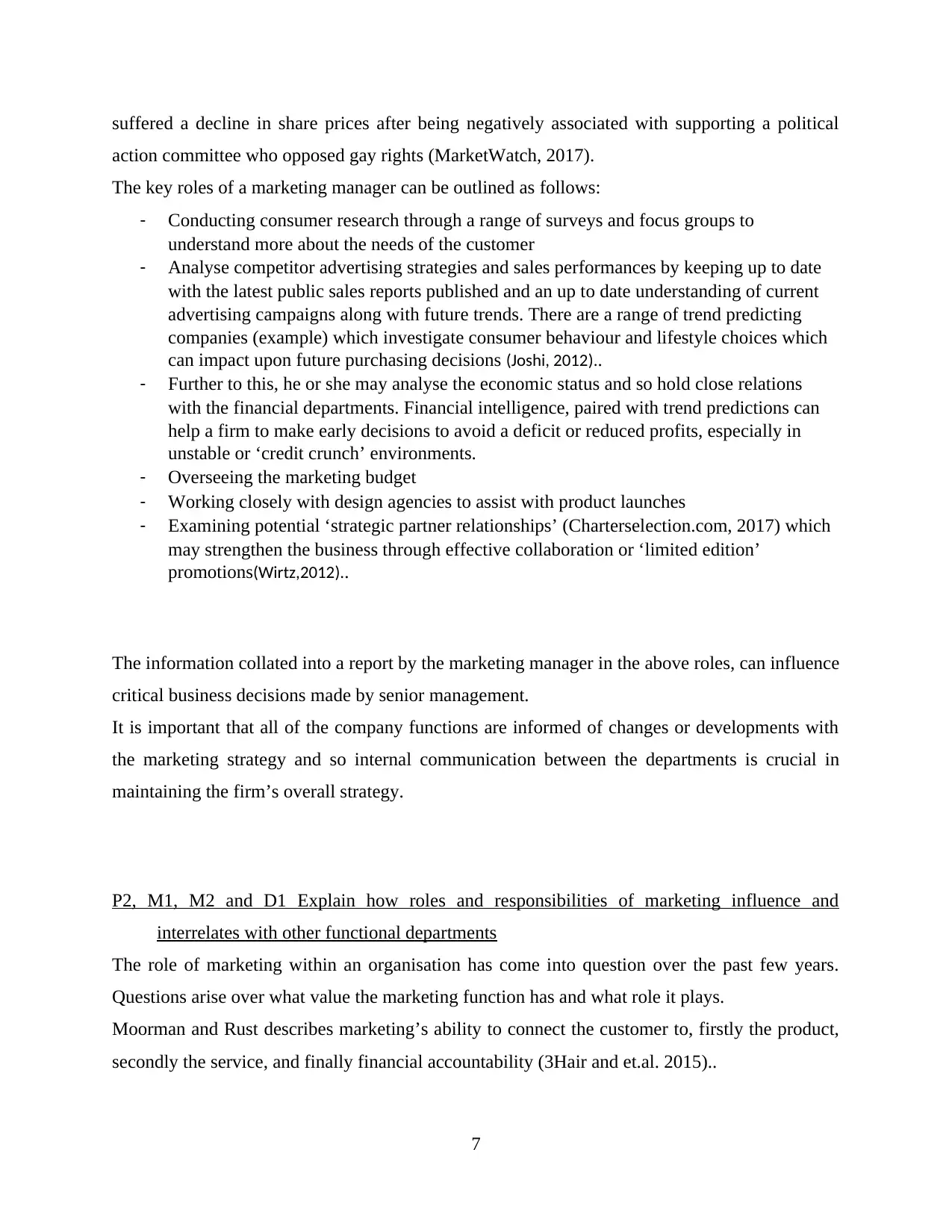
suffered a decline in share prices after being negatively associated with supporting a political
action committee who opposed gay rights (MarketWatch, 2017).
The key roles of a marketing manager can be outlined as follows:
- Conducting consumer research through a range of surveys and focus groups to
understand more about the needs of the customer
- Analyse competitor advertising strategies and sales performances by keeping up to date
with the latest public sales reports published and an up to date understanding of current
advertising campaigns along with future trends. There are a range of trend predicting
companies (example) which investigate consumer behaviour and lifestyle choices which
can impact upon future purchasing decisions (Joshi, 2012)..
- Further to this, he or she may analyse the economic status and so hold close relations
with the financial departments. Financial intelligence, paired with trend predictions can
help a firm to make early decisions to avoid a deficit or reduced profits, especially in
unstable or ‘credit crunch’ environments.
- Overseeing the marketing budget
- Working closely with design agencies to assist with product launches
- Examining potential ‘strategic partner relationships’ (Charterselection.com, 2017) which
may strengthen the business through effective collaboration or ‘limited edition’
promotions(Wirtz,2012)..
The information collated into a report by the marketing manager in the above roles, can influence
critical business decisions made by senior management.
It is important that all of the company functions are informed of changes or developments with
the marketing strategy and so internal communication between the departments is crucial in
maintaining the firm’s overall strategy.
P2, M1, M2 and D1 Explain how roles and responsibilities of marketing influence and
interrelates with other functional departments
The role of marketing within an organisation has come into question over the past few years.
Questions arise over what value the marketing function has and what role it plays.
Moorman and Rust describes marketing’s ability to connect the customer to, firstly the product,
secondly the service, and finally financial accountability (3Hair and et.al. 2015)..
7
action committee who opposed gay rights (MarketWatch, 2017).
The key roles of a marketing manager can be outlined as follows:
- Conducting consumer research through a range of surveys and focus groups to
understand more about the needs of the customer
- Analyse competitor advertising strategies and sales performances by keeping up to date
with the latest public sales reports published and an up to date understanding of current
advertising campaigns along with future trends. There are a range of trend predicting
companies (example) which investigate consumer behaviour and lifestyle choices which
can impact upon future purchasing decisions (Joshi, 2012)..
- Further to this, he or she may analyse the economic status and so hold close relations
with the financial departments. Financial intelligence, paired with trend predictions can
help a firm to make early decisions to avoid a deficit or reduced profits, especially in
unstable or ‘credit crunch’ environments.
- Overseeing the marketing budget
- Working closely with design agencies to assist with product launches
- Examining potential ‘strategic partner relationships’ (Charterselection.com, 2017) which
may strengthen the business through effective collaboration or ‘limited edition’
promotions(Wirtz,2012)..
The information collated into a report by the marketing manager in the above roles, can influence
critical business decisions made by senior management.
It is important that all of the company functions are informed of changes or developments with
the marketing strategy and so internal communication between the departments is crucial in
maintaining the firm’s overall strategy.
P2, M1, M2 and D1 Explain how roles and responsibilities of marketing influence and
interrelates with other functional departments
The role of marketing within an organisation has come into question over the past few years.
Questions arise over what value the marketing function has and what role it plays.
Moorman and Rust describes marketing’s ability to connect the customer to, firstly the product,
secondly the service, and finally financial accountability (3Hair and et.al. 2015)..
7
Paraphrase This Document
Need a fresh take? Get an instant paraphrase of this document with our AI Paraphraser
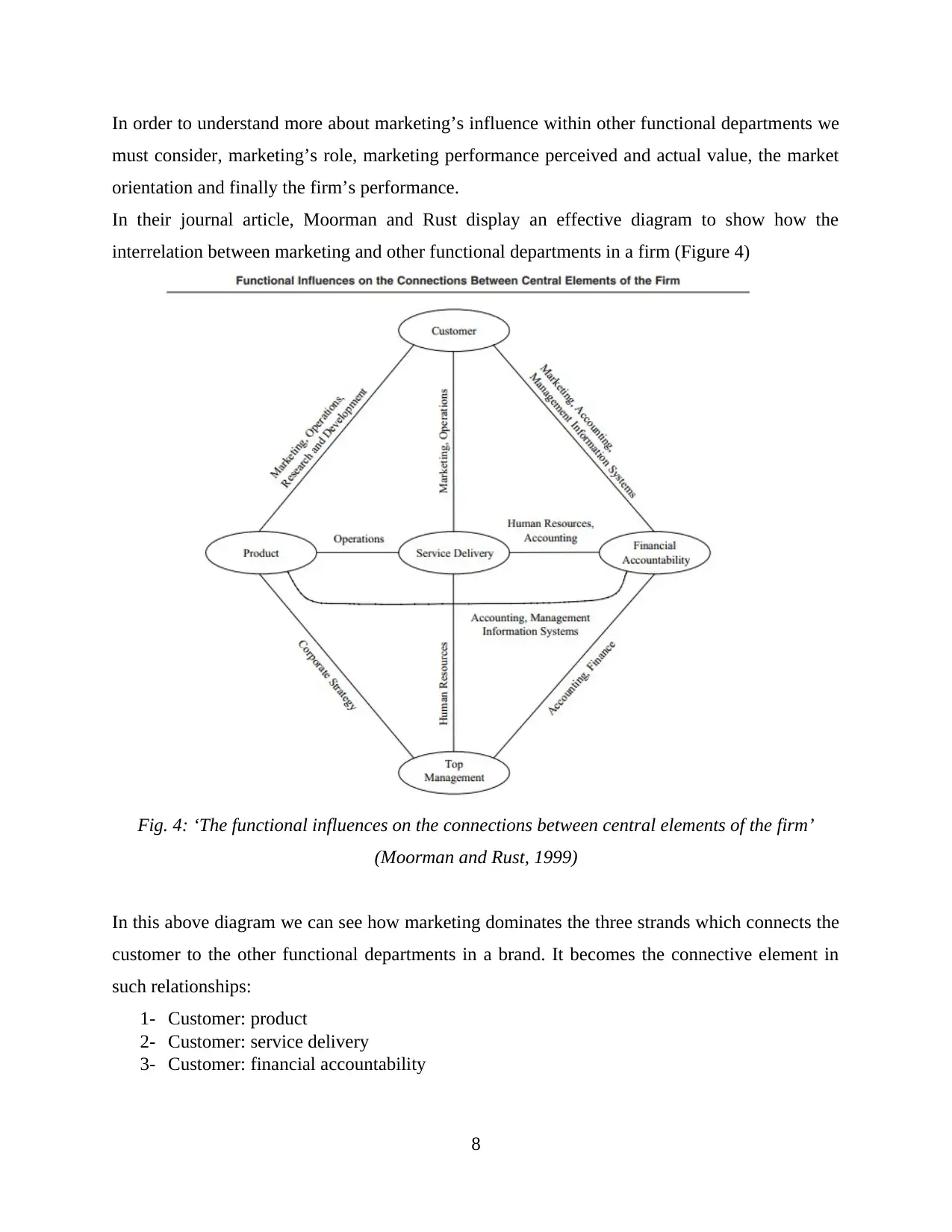
In order to understand more about marketing’s influence within other functional departments we
must consider, marketing’s role, marketing performance perceived and actual value, the market
orientation and finally the firm’s performance.
In their journal article, Moorman and Rust display an effective diagram to show how the
interrelation between marketing and other functional departments in a firm (Figure 4)
Fig. 4: ‘The functional influences on the connections between central elements of the firm’
(Moorman and Rust, 1999)
In this above diagram we can see how marketing dominates the three strands which connects the
customer to the other functional departments in a brand. It becomes the connective element in
such relationships:
1- Customer: product
2- Customer: service delivery
3- Customer: financial accountability
8
must consider, marketing’s role, marketing performance perceived and actual value, the market
orientation and finally the firm’s performance.
In their journal article, Moorman and Rust display an effective diagram to show how the
interrelation between marketing and other functional departments in a firm (Figure 4)
Fig. 4: ‘The functional influences on the connections between central elements of the firm’
(Moorman and Rust, 1999)
In this above diagram we can see how marketing dominates the three strands which connects the
customer to the other functional departments in a brand. It becomes the connective element in
such relationships:
1- Customer: product
2- Customer: service delivery
3- Customer: financial accountability
8
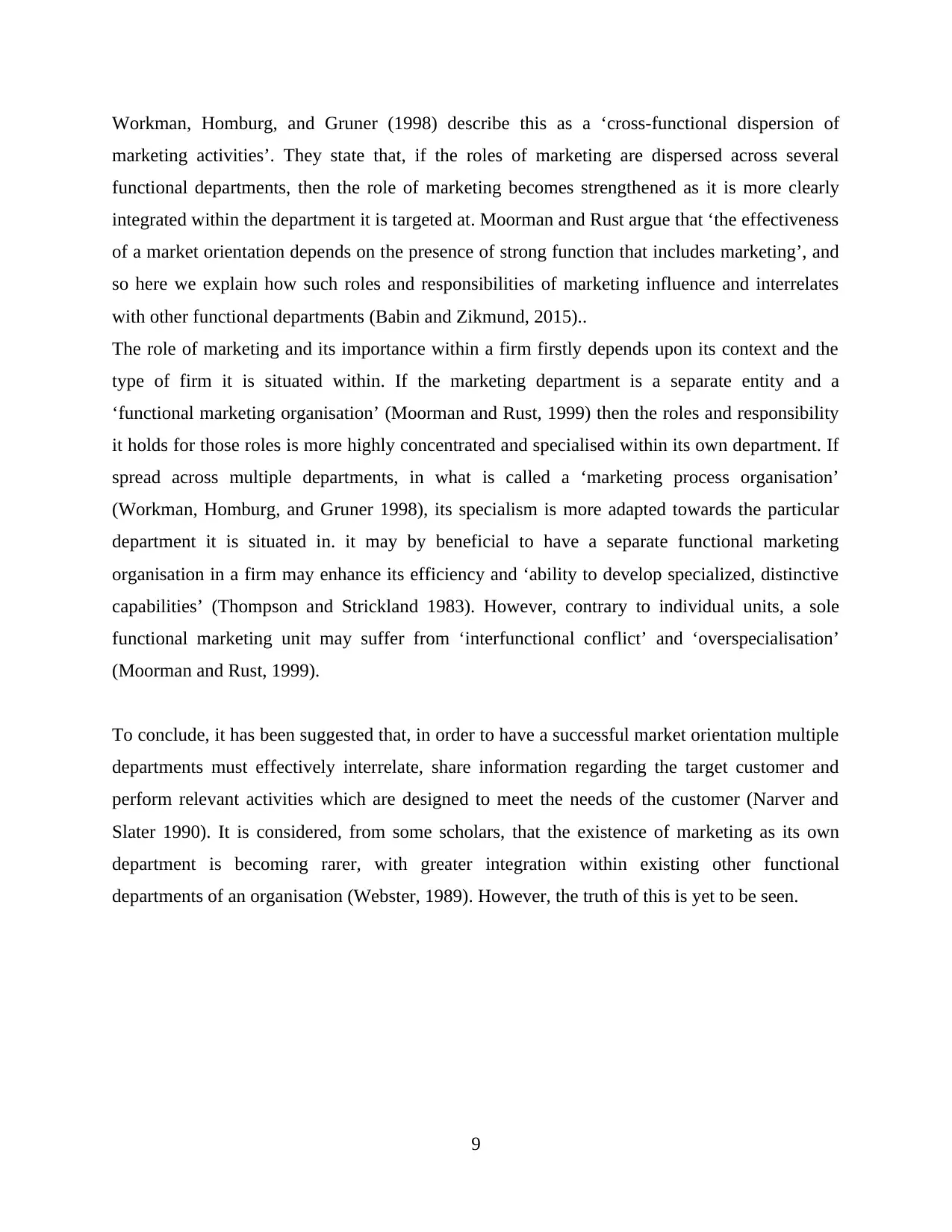
Workman, Homburg, and Gruner (1998) describe this as a ‘cross-functional dispersion of
marketing activities’. They state that, if the roles of marketing are dispersed across several
functional departments, then the role of marketing becomes strengthened as it is more clearly
integrated within the department it is targeted at. Moorman and Rust argue that ‘the effectiveness
of a market orientation depends on the presence of strong function that includes marketing’, and
so here we explain how such roles and responsibilities of marketing influence and interrelates
with other functional departments (Babin and Zikmund, 2015)..
The role of marketing and its importance within a firm firstly depends upon its context and the
type of firm it is situated within. If the marketing department is a separate entity and a
‘functional marketing organisation’ (Moorman and Rust, 1999) then the roles and responsibility
it holds for those roles is more highly concentrated and specialised within its own department. If
spread across multiple departments, in what is called a ‘marketing process organisation’
(Workman, Homburg, and Gruner 1998), its specialism is more adapted towards the particular
department it is situated in. it may by beneficial to have a separate functional marketing
organisation in a firm may enhance its efficiency and ‘ability to develop specialized, distinctive
capabilities’ (Thompson and Strickland 1983). However, contrary to individual units, a sole
functional marketing unit may suffer from ‘interfunctional conflict’ and ‘overspecialisation’
(Moorman and Rust, 1999).
To conclude, it has been suggested that, in order to have a successful market orientation multiple
departments must effectively interrelate, share information regarding the target customer and
perform relevant activities which are designed to meet the needs of the customer (Narver and
Slater 1990). It is considered, from some scholars, that the existence of marketing as its own
department is becoming rarer, with greater integration within existing other functional
departments of an organisation (Webster, 1989). However, the truth of this is yet to be seen.
9
marketing activities’. They state that, if the roles of marketing are dispersed across several
functional departments, then the role of marketing becomes strengthened as it is more clearly
integrated within the department it is targeted at. Moorman and Rust argue that ‘the effectiveness
of a market orientation depends on the presence of strong function that includes marketing’, and
so here we explain how such roles and responsibilities of marketing influence and interrelates
with other functional departments (Babin and Zikmund, 2015)..
The role of marketing and its importance within a firm firstly depends upon its context and the
type of firm it is situated within. If the marketing department is a separate entity and a
‘functional marketing organisation’ (Moorman and Rust, 1999) then the roles and responsibility
it holds for those roles is more highly concentrated and specialised within its own department. If
spread across multiple departments, in what is called a ‘marketing process organisation’
(Workman, Homburg, and Gruner 1998), its specialism is more adapted towards the particular
department it is situated in. it may by beneficial to have a separate functional marketing
organisation in a firm may enhance its efficiency and ‘ability to develop specialized, distinctive
capabilities’ (Thompson and Strickland 1983). However, contrary to individual units, a sole
functional marketing unit may suffer from ‘interfunctional conflict’ and ‘overspecialisation’
(Moorman and Rust, 1999).
To conclude, it has been suggested that, in order to have a successful market orientation multiple
departments must effectively interrelate, share information regarding the target customer and
perform relevant activities which are designed to meet the needs of the customer (Narver and
Slater 1990). It is considered, from some scholars, that the existence of marketing as its own
department is becoming rarer, with greater integration within existing other functional
departments of an organisation (Webster, 1989). However, the truth of this is yet to be seen.
9
⊘ This is a preview!⊘
Do you want full access?
Subscribe today to unlock all pages.

Trusted by 1+ million students worldwide
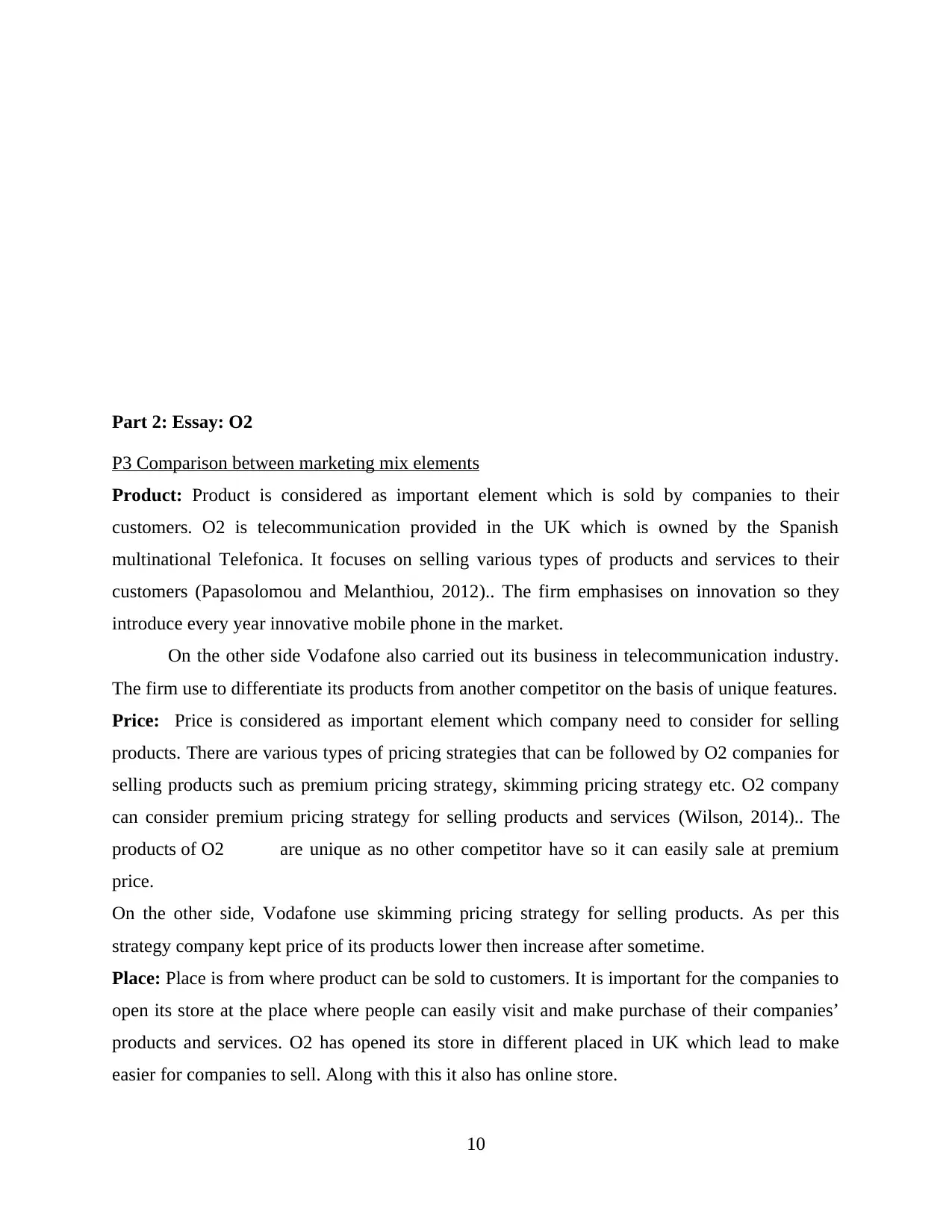
Part 2: Essay: O2
P3 Comparison between marketing mix elements
Product: Product is considered as important element which is sold by companies to their
customers. O2 is telecommunication provided in the UK which is owned by the Spanish
multinational Telefonica. It focuses on selling various types of products and services to their
customers (Papasolomou and Melanthiou, 2012).. The firm emphasises on innovation so they
introduce every year innovative mobile phone in the market.
On the other side Vodafone also carried out its business in telecommunication industry.
The firm use to differentiate its products from another competitor on the basis of unique features.
Price: Price is considered as important element which company need to consider for selling
products. There are various types of pricing strategies that can be followed by O2 companies for
selling products such as premium pricing strategy, skimming pricing strategy etc. O2 company
can consider premium pricing strategy for selling products and services (Wilson, 2014).. The
products of O2 are unique as no other competitor have so it can easily sale at premium
price.
On the other side, Vodafone use skimming pricing strategy for selling products. As per this
strategy company kept price of its products lower then increase after sometime.
Place: Place is from where product can be sold to customers. It is important for the companies to
open its store at the place where people can easily visit and make purchase of their companies’
products and services. O2 has opened its store in different placed in UK which lead to make
easier for companies to sell. Along with this it also has online store.
10
P3 Comparison between marketing mix elements
Product: Product is considered as important element which is sold by companies to their
customers. O2 is telecommunication provided in the UK which is owned by the Spanish
multinational Telefonica. It focuses on selling various types of products and services to their
customers (Papasolomou and Melanthiou, 2012).. The firm emphasises on innovation so they
introduce every year innovative mobile phone in the market.
On the other side Vodafone also carried out its business in telecommunication industry.
The firm use to differentiate its products from another competitor on the basis of unique features.
Price: Price is considered as important element which company need to consider for selling
products. There are various types of pricing strategies that can be followed by O2 companies for
selling products such as premium pricing strategy, skimming pricing strategy etc. O2 company
can consider premium pricing strategy for selling products and services (Wilson, 2014).. The
products of O2 are unique as no other competitor have so it can easily sale at premium
price.
On the other side, Vodafone use skimming pricing strategy for selling products. As per this
strategy company kept price of its products lower then increase after sometime.
Place: Place is from where product can be sold to customers. It is important for the companies to
open its store at the place where people can easily visit and make purchase of their companies’
products and services. O2 has opened its store in different placed in UK which lead to make
easier for companies to sell. Along with this it also has online store.
10
Paraphrase This Document
Need a fresh take? Get an instant paraphrase of this document with our AI Paraphraser
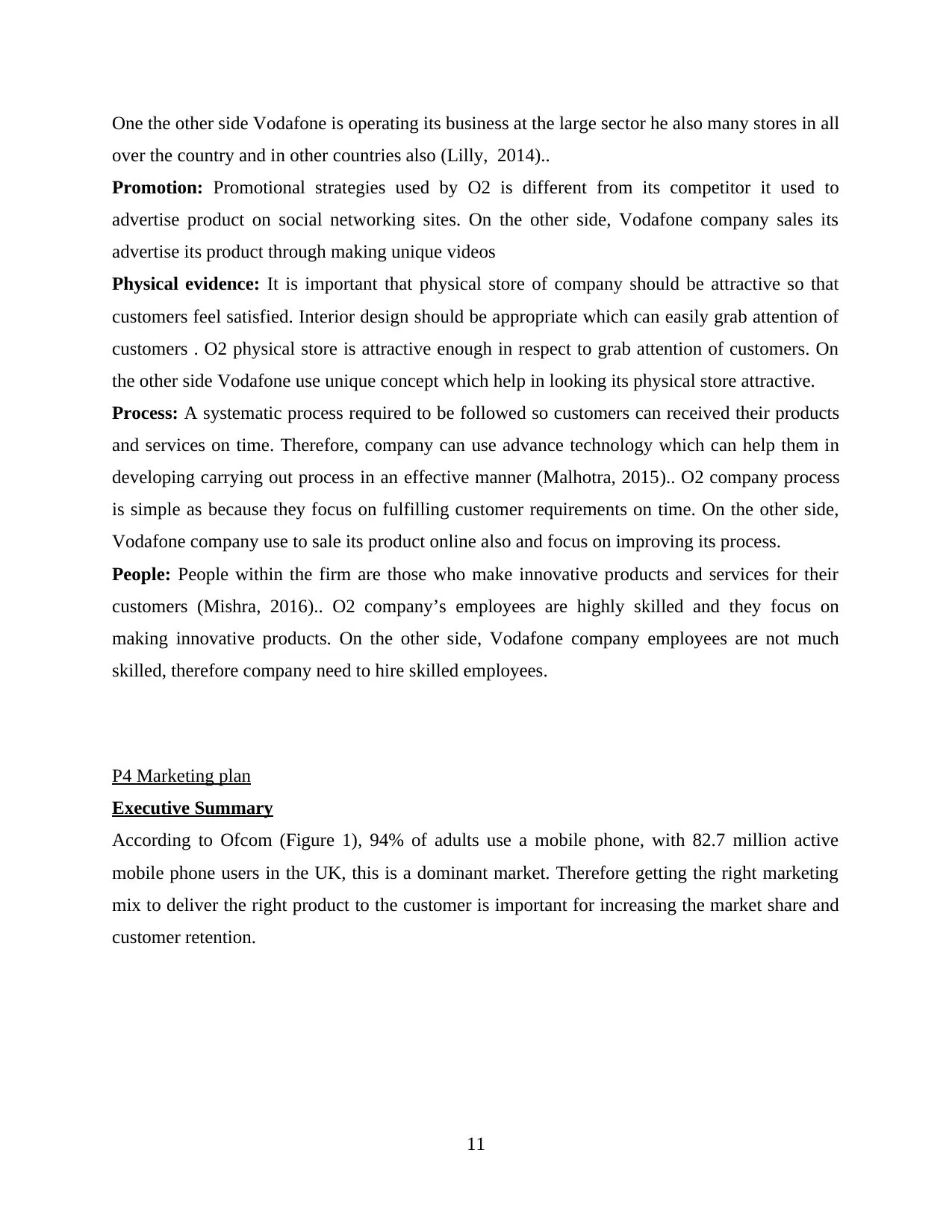
One the other side Vodafone is operating its business at the large sector he also many stores in all
over the country and in other countries also (Lilly, 2014)..
Promotion: Promotional strategies used by O2 is different from its competitor it used to
advertise product on social networking sites. On the other side, Vodafone company sales its
advertise its product through making unique videos
Physical evidence: It is important that physical store of company should be attractive so that
customers feel satisfied. Interior design should be appropriate which can easily grab attention of
customers . O2 physical store is attractive enough in respect to grab attention of customers. On
the other side Vodafone use unique concept which help in looking its physical store attractive.
Process: A systematic process required to be followed so customers can received their products
and services on time. Therefore, company can use advance technology which can help them in
developing carrying out process in an effective manner (Malhotra, 2015).. O2 company process
is simple as because they focus on fulfilling customer requirements on time. On the other side,
Vodafone company use to sale its product online also and focus on improving its process.
People: People within the firm are those who make innovative products and services for their
customers (Mishra, 2016).. O2 company’s employees are highly skilled and they focus on
making innovative products. On the other side, Vodafone company employees are not much
skilled, therefore company need to hire skilled employees.
P4 Marketing plan
Executive Summary
According to Ofcom (Figure 1), 94% of adults use a mobile phone, with 82.7 million active
mobile phone users in the UK, this is a dominant market. Therefore getting the right marketing
mix to deliver the right product to the customer is important for increasing the market share and
customer retention.
11
over the country and in other countries also (Lilly, 2014)..
Promotion: Promotional strategies used by O2 is different from its competitor it used to
advertise product on social networking sites. On the other side, Vodafone company sales its
advertise its product through making unique videos
Physical evidence: It is important that physical store of company should be attractive so that
customers feel satisfied. Interior design should be appropriate which can easily grab attention of
customers . O2 physical store is attractive enough in respect to grab attention of customers. On
the other side Vodafone use unique concept which help in looking its physical store attractive.
Process: A systematic process required to be followed so customers can received their products
and services on time. Therefore, company can use advance technology which can help them in
developing carrying out process in an effective manner (Malhotra, 2015).. O2 company process
is simple as because they focus on fulfilling customer requirements on time. On the other side,
Vodafone company use to sale its product online also and focus on improving its process.
People: People within the firm are those who make innovative products and services for their
customers (Mishra, 2016).. O2 company’s employees are highly skilled and they focus on
making innovative products. On the other side, Vodafone company employees are not much
skilled, therefore company need to hire skilled employees.
P4 Marketing plan
Executive Summary
According to Ofcom (Figure 1), 94% of adults use a mobile phone, with 82.7 million active
mobile phone users in the UK, this is a dominant market. Therefore getting the right marketing
mix to deliver the right product to the customer is important for increasing the market share and
customer retention.
11
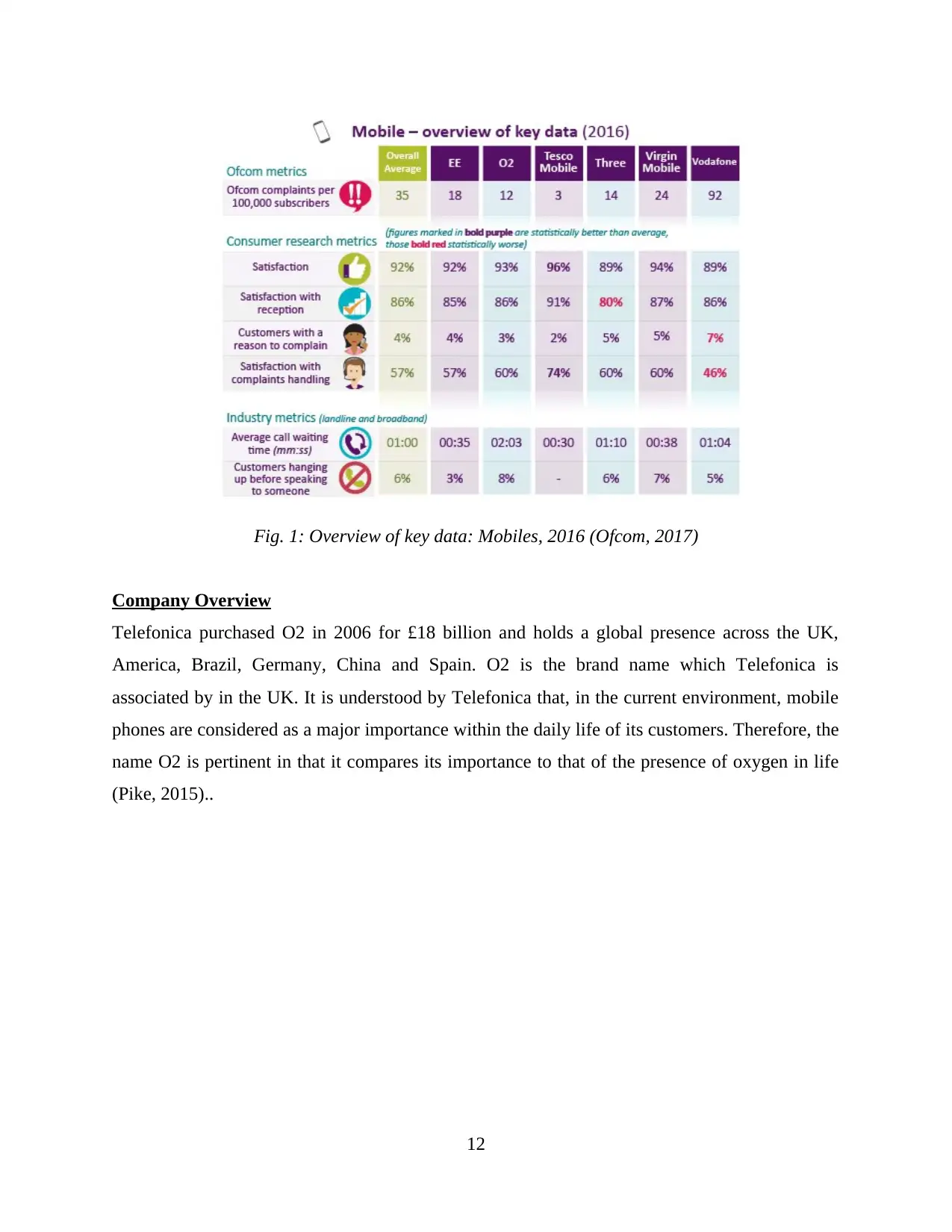
Fig. 1: Overview of key data: Mobiles, 2016 (Ofcom, 2017)
Company Overview
Telefonica purchased O2 in 2006 for £18 billion and holds a global presence across the UK,
America, Brazil, Germany, China and Spain. O2 is the brand name which Telefonica is
associated by in the UK. It is understood by Telefonica that, in the current environment, mobile
phones are considered as a major importance within the daily life of its customers. Therefore, the
name O2 is pertinent in that it compares its importance to that of the presence of oxygen in life
(Pike, 2015)..
12
Company Overview
Telefonica purchased O2 in 2006 for £18 billion and holds a global presence across the UK,
America, Brazil, Germany, China and Spain. O2 is the brand name which Telefonica is
associated by in the UK. It is understood by Telefonica that, in the current environment, mobile
phones are considered as a major importance within the daily life of its customers. Therefore, the
name O2 is pertinent in that it compares its importance to that of the presence of oxygen in life
(Pike, 2015)..
12
⊘ This is a preview!⊘
Do you want full access?
Subscribe today to unlock all pages.

Trusted by 1+ million students worldwide
1 out of 27
Related Documents
Your All-in-One AI-Powered Toolkit for Academic Success.
+13062052269
info@desklib.com
Available 24*7 on WhatsApp / Email
![[object Object]](/_next/static/media/star-bottom.7253800d.svg)
Unlock your academic potential
Copyright © 2020–2025 A2Z Services. All Rights Reserved. Developed and managed by ZUCOL.




